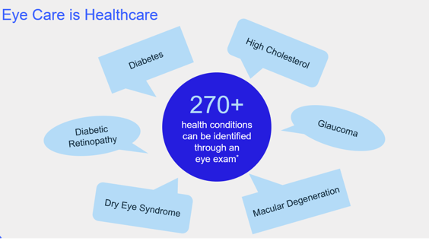Vision Benefits: The Surprising Solution to Curb Rising Healthcare Costs
In this 5-minute read:
Prefer video?
Listen to Dr. Valerie Sheety-Pilon, Vice President of Clinical and Medical Affairs at VSP® Vision Care present on the profound impact of vision benefits on eye health and its relationship to cost savings when it comes to chronic conditions. Watch the full 20-minute presentation or see the transcript.
How Vision Benefits Provide Value and Help Battle Rising Healthcare Costs
In today’s economy, the cost of nearly everything is increasing, and health benefits are no exception. With experts forecasting a 7% cost hike in 20241 and inflation squeezing our wallets, companies face a dilemma: absorb the costs or pass them on to their employees.
While companies decide where to focus and what to prioritize for their employees, the importance of vision benefits can often be overlooked. Not only can a routine annual eye exam detect over 270 health conditions2 but having vision benefits can result in lower healthcare costs long term.
The Troubling Price of Healthcare
We all know too well that we’re living in a world of rising costs. The salad or burger we used to pick up at the local drive thru is now $8—up from $5 just a few weeks ago. While inflation is starting to slow, the rising cost of healthcare continues to trickle down to organizations offering group benefits and their workforce.
PwC Health Research Institute noted in their 2024 medical cost trends report: “In a persisting high inflationary environment, hospitals and providers will ultimately be pushed to seek significant rate increases from payers. Many health plan actuaries said they are facing increasing inflationary pressure on unit cost in 2023 and 2024.”
Pairing these rate hikes with higher costs for pharmaceuticals, healthcare costs in 2024 are forecasted to rise 7%, up from 5.5% in 2022 and 6% in 2023.1 This becomes more concerning when you hear that rising healthcare costs rank as a top financial worry for U.S. adults with 4 out of 10 people saying they have delayed or gone without medical care within the last year due to cost.iii
Curious about how much you could save on healthcare costs?
Costs Surge with Chronic Conditions
Now more than ever, investing in employees' health and well-being is a wise strategy for any organization. Not only does it help create healthier and happier workforces, but there are positive gains to the wallet too.
Research shows that employers incur $1,320 per year in healthcare costs for a healthy employee. However, as chronic conditions occur, the costs increase significantly. Approximately one in four U.S. adults has more than one chronic condition and, for those with multiple conditions, costs surge by 8.2 times to $10,830 per year.4
Preventative Care through Vision Benefits
A regular eye exam is often an underestimated solution to keep employees in the “healthy” bucket and minimize the costs associated with multiple chronic conditions.
Not only can it detect vision problems but also serves as a preventive measure for various health conditions. Over 270 health conditions can be detected through a comprehensive eye exam.

Spotlight on Diabetes
An independent study found that 34% of diabetes cases were first identified through vision claims rather than medical claims. Early detection through vision benefits allows individuals to seek timely medical care, potentially reducing the likelihood of hospital visits and extra out-of-pocket costs.5
The study also revealed that patients who made vision claims required fewer prescriptions, and fewer co-pays, and were more likely to seek further preventive care after their initial vision claim.
By including vision benefits in your comprehensive benefits package, you can aid in the detection of chronic conditions, facilitating timely intervention and potentially reducing the long-term impact on employees' eye health, healthcare costs, and overall well-being.
Eye Exame 1st Indicator
34%
Likelihood of ER Visit
27% Less
Likelihood of Hospital Admission
4% Less
Required a Prescription
9% Less
Received Preventative Care
12% More
Reduction in Medical Care When Diabetes Is First Identified Through Vision Claims
Eye Exam 1st Indicator | Likelihood of ER Visit | Likelihood of Hospital Admission | Required a Prescription | Received Preventative Care | |
|---|---|---|---|---|---|
| Diabetes | 34% | 27% Less | 4% Less | 9% Less | 12% More |
In five seconds, see how much you and your employees could save on healthcare costs with VSP Vision Care.
See the Savings
A recent study showed that those with chronic conditions also gain significant cost avoidance by partnering with VSP versus other vision care providers.
Annual Savings for Employee with Diabetes
$1,733
Annual Savings for Employee with Hypertension
$2,633
Employers and employees are curbing their healthcare costs with vision coverage from VSP. Below are just some of the ways VSP can help you save more:
No Cost Care
Critical screenings and medical eye exams for members with diabetes
Encourage Use of Benefits
Send eye exam reminders to members with diabetes, resulting in 22% getting an exam
More Access to Care
Exchange HIPPA-compliant medical data with health plans and disease management vendors to identify members with chronic conditions and get them the care they need
About VSP Vision Care
VSP was founded in 1955 and today is the largest vision insurance company. As the only national not-for-profit vision benefits company, VSP Vision Care provides access to eye care for over 85 million members through a network of more than 42,000 doctors. To learn more about how VSP vision benefits can help your company and employees, visit getvsp.com.
